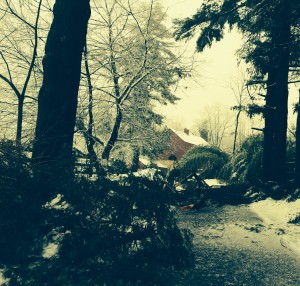Recovery from ice storm, including power restoration, could take days
Patience: That’s what government officials are recommending as county residents – most without power – attempt to rebound from the ice storm.
With some exceptions where large trees fell, most county roads are passable; however, many resemble accident scenes with shards of ice from tree limbs littering the surface. On Thursday morning, Feb. 6, PECO reported that more than 128,000 of its nearly 210,000 Chester County customers remained in the dark, a situation that could persist into the weekend.
The county is urging residents who need shelter to go to the Sturzbecker Health Center at West Chester University, 855 S. New Street, West Chester, where overnight facilities have been consolidated. This shelter is pet-friendly – pets are being housed in a separate building from the human residents – cages and food will be available.
Those who simply need a place to get warm – but where services are more limited – can visit Pope John Paul School, 2875 Manor Road, Coatesville; Cochranville Fire Company 3135 Limestone Road,Cochranville; or Coatesville City Hall – open until 4:30 p.m. on Thursday, Feb. 6 – One City Hall Place,Coatesville.
Anyone needing transportation to a shelter or warming station should call 610-344-5195. All Chester County facilities – with the exception of the courts and Justice Center – are closed on Thursday, Feb. 6. For more information and tips from the county, visit www.chesco.org/des.
Chester County Emergency Management officials are encouraging residents to use caution when utilizing backup generators. If installed and operated correctly, the use of standby or portable electric generators poses little danger, but improper installation or use could be dangerous.
The county offers these tips for the safe operation and use of portable generators:
- Incorrect generator use can lead to carbon monoxide (CO) poisoning from the toxic engine exhaust, electric shock or electrocution and fire. Follow the directions supplied with the generator.
- Never use a portable generator in a garage, carport, basement, crawl space or other enclosed or partially-enclosed area, even with ventilation. Opening doors and windows or using fans will not prevent CO buildup in the home.
- If you start to feel sick, dizzy, or weak while using a generator, get to fresh air right away — do not delay!
- Install home CO alarms that are battery-operated or have battery back-up. Test batteries frequently and replace when needed.
- Place generators in a dry, outside location, away from windows, doors, and vents that could allow CO to come indoors.
- Generators should be at least 20 feet away from buildings. Even 20 feet away, air flow patterns could still blow carbon monoxide into homes through attic vents, windows, or doors, so it’s very important to have a working carbon monoxide detector inside the home.
- To avoid electrocution, keep the generator dry. Do not use in rain or wet conditions. Operate it on a dry surface under an open canopy-like structure. Make sure your hands are dry before touching the generator.
- Turn the generator off and let it cool before refueling. Gasoline spilled on hot engine parts could ignite.
- Store generator fuel in an approved safety can outside of living areas in a locked shed or other protected area. Local laws may restrict use or storage of fuel. Ask your local fire department for information.
- If you spill fuel or do not seal its container properly, invisible vapors can travel along the ground and be ignited by an appliance’s pilot light or arcs from electric switches in the appliance.
- Use the type of fuel recommended in the generator instructions or on its label.
- Protect your appliances. Turn off or disconnect all appliances and lights before you begin operating the portable generator. Once the generator is running, turn your appliances and lights on one at a time to avoid overloading the unit.
- Use proper extension cords. Use only safety-tested, shop-type electrical cords designed and rated for heavier, outdoor use to connect appliances. Many generators are equipped with twist-lock connects to reduce the chance of accidental disconnections due to vibrations.
- Never try to power house wiring by plugging the generator into a wall outlet, a practice known as “back feeding.” It can lead to the electrocution of utility workers or neighbors served by the same utility transformer.
- The only safe way to connect a generator to house wiring is to have a qualified electrician install a power transfer switch.
- Shut down generators properly. Before shutting down a generator, turn off and unplug all appliances and equipment being powered by the generator.
- Remember maintenance between uses. It’s important to drain the gasoline from the generator while it is being stored. It’s also a good idea to inspect the fuel and oil filters, spark plug, oil level and fuel quality and start the generator on a regular basis before an emergency situation happens.








